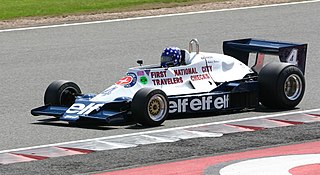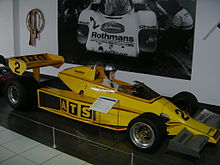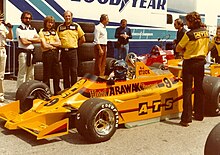Teodorico Fabi is an Italian former racing driver. He competed in Formula One, IndyCar, and sports car racing. He claimed pole position in his rookie year at the 1983 Indianapolis 500. Teo is the older brother of former Formula One driver Corrado Fabi.
Stefano Modena is a former racing driver from Italy. He participated in 81 Formula One Grands Prix, debuting on 15 November 1987. He achieved 2 podiums, and scored a total of 17 championship points.
ATS is a German company that manufactures alloy wheels for road and racing cars. It is based in Bad Dürkheim near the Hockenheimring race circuit. ATS had a Formula One racing team that was active from 1977 to 1984.

The Brabham BT49 is a Formula One racing car designed by South African Gordon Murray for the British Brabham team. The BT49 competed in the 1979 to 1982 Formula One World Championships and was used by Brazilian driver Nelson Piquet to win his first World Championship in 1981.

The McLaren MP4/1 was a Formula One racing car produced by the McLaren team. It was used during the 1981, 1982 and 1983 seasons. It was the second Formula One car to use a monocoque chassis wholly manufactured from carbon fibre composite, after the Lotus 88, a concept which is now ubiquitous. The MP4 was first entered in a Formula One race at the third Grand Prix of the 1981 season in Argentina.

The Jordan 191 was a Formula One car designed by Gary Anderson for use by Jordan Grand Prix in its debut season in 1991. Its best finish was in Canada and Mexico, where Andrea de Cesaris drove it to fourth place at both races. Driving the 191 at the 1991 Hungarian Grand Prix, Bertrand Gachot took the fastest lap of the race.

The Tyrrell 011 was a Formula One car designed by Maurice Philippe for the Tyrrell Racing Organisation.

The Brabham BT50 was a Formula One racing car designed by Gordon Murray and powered by a turbo BMW engine. It was raced by the Brabham team, owned by Bernie Ecclestone, during the 1982 Formula One season. Driven by Nelson Piquet and Riccardo Patrese, it made its debut at the South African Grand Prix before being withdrawn for further development of its engine while the team reverted to the previous year's car, the Brabham BT49. On the reintroduction of the BT50, Piquet finished fifth in the Belgian Grand Prix. A few races later he drove it to a win in the Canadian Grand Prix. Later in the year it achieved three more finishes in the points for the team. During the second half of the season, Brabham implemented the strategy of mid-race refueling. This allowed Piquet and Patrese to start the races relatively light and use their reduced weight to gain track position over their competitors before stopping to refuel. The poor reliability of the BT50 meant that they had only a few opportunities to demonstrate the strategy in practice.

The Shadow DN1 was a Formula One car used by the Shadow team during the 1973 Formula One season and the early stages of the following season. The car was the first Formula One car for Shadow, which had previously participated in the CanAm Sportscar Series. It was designed by former BRM engineer Tony Southgate. The DN1 was also driven by Graham Hill for his privateer team, Embassy Hill.

The Ligier JS9 was a Formula One racing car manufactured and raced by Ligier during the 1978 Formula One season. Driven by Frenchman Jacques Laffite, its best finish was third (twice).
The Ligier JS21 was a Formula One racing car manufactured and raced by Ligier during the 1983 Formula One season. Powered by a Cosworth V8 engine while the majority of teams used turbo power, the team failed to score any points.

The ATS D6 was a Formula One racing car manufactured and raced by the Team ATS during the 1983 Formula One season. It was powered by the BMW M12/13 4-cylinder turbocharged engine but the team failed to score any points.
The ATS D1 was a Formula One racing car manufactured and raced by the ATS Racing Team for the last two races of the 1978 Formula One season. It was powered by a Cosworth DFV V8 engine. Driven by Keke Rosberg, the D1 failed to finish any races in the points.
The Rial ARC1 was a Formula One racing car manufactured and raced by Rial Racing for the 1988 Formula One season. It was powered by a Cosworth DFZ V8 engine. Its best finish was at the 1988 United States Grand Prix when Andrea de Cesaris drove it to fourth place.
The Rial ARC2 was a Formula One racing car manufactured and raced by Rial Racing for the 1989 Formula One season. It was powered by a Cosworth DFR V8 engine. Its best finish was at the 1989 United States Grand Prix when Christian Danner drove it to fourth place.

The Penske PC4 was a Formula One car used by Team Penske during the 1976 and was driven to victory in that year's Austrian Grand Prix by John Watson, scoring the last win for an American-licensed constructor in a F1 race. It was used for most of the following season by ATS Racing and Interscope Racing also used the PC4 for two races that year.

The Tyrrell 008 was a Formula One car manufactured and raced by the Tyrrell Racing Organisation team during the 1978 season. Driven by Didier Pironi and Patrick Depailler, it achieved several podium finishes including a win at the 1978 Monaco Grand Prix.

The ATS D5 was a Formula One racing car manufactured and raced by the Team ATS racing team during the 1981 and 1982 Formula One seasons. Originally known as the HGS1 in 1981, it was updated for 1982 and designated the D5. It was powered by the Ford-Cosworth DFV V8. The team scored five points with the chassis across the two seasons it was raced.

The Ligier JS17 was a Formula One car designed by Gérard Ducarouge and Michel Beaujon for use by the Ligier team during the 1981 season. Powered by a Talbot-badged Matra V12, the JS17 was driven to two Grand Prix wins by Jacques Laffite. It was updated to JS17B specification for the 1982 season until it was replaced later that year by the JS19.

The ATS HS1 was a Formula One car used by ATS during the 1978 Formula One season. It was designed by John Gentry and Robin Herd.














